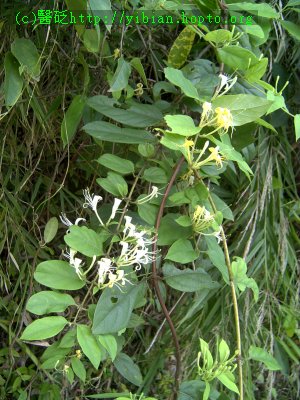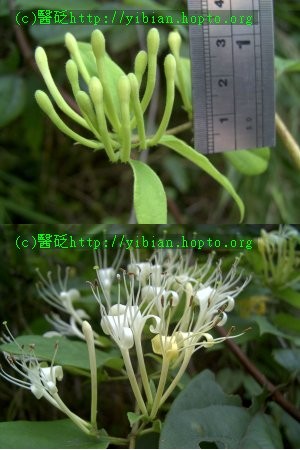| common name | Lonicera Jin Yin Hua |
| alias | Honeysuckle Flower Ren Dong |
This product is the flower bud of the honeysuckle flower (Lonicera japonica Thunb.), a perennial semi-evergreen climbing woody vine of the honeysuckle family. It is distributed throughout the north and south of mainland China. The buds are picked in early summer when they are still unopened, then dried in the shade. They can be used raw, stir-fried, or processed into a distillate.
bubble_chart Morphological Characteristics


Sweet, cold. Act on lung, heart and stomach meridians.
Clearing heat and removing toxin, releasing exterior with pungent-cool.
- Used for boils and sores. This product is sweet and cold in nature, clearing heat and removing toxin, dispersing abscesses and reducing swelling, making it an essential medicine for treating all types of boils and sores with yang pattern. For initial stages of boils and sores with redness, heat, swelling, and pain, it can be used alone by decoction or applied as a residue to the affected area. It can also be combined with Gleditsia Spine, Pangolin Scales, Dahurian Angelica in a combination of medicinals, such as Immortal Formula Life-Saving Decoction. For severe boils and sores with redness, heat, swelling, pain, and deep-rooted hardness, it is often used with Tokyo Violet Herb, Dandelion, wild chrysanthemum flower, such as in Five-Ingredient Toxin-Eliminating Decoction. For intestinal abscess with abdominal pain, it is often combined with Chinese Angelica, Sanguisorba, Skullcap Root in a combination of medicinals, such as Intestine-Cleaning Decoction. For lung abscess with coughing and expectoration of pus and blood, it is often used with Heartleaf Houttuynia Herb, Reed Rhizome, Peach Kernel to clear the lungs and expel pus.
- Used for external contraction of wind-heat and initial stages of warm disease. This product is sweet and cold in nature, aromatic and dispersing, effectively dispersing lung pathogenic heat, clearing heart and stomach heat toxin. It is often used with Forsythia, Mentha, Great Burdock Achene, such as in Lonicera and Forsythia Powder. If heat enters the nutrient-blood level, causing crimson tongue, unconsciousness, and irritability with insomnia, it is often combined with Unprocessed Rehmannia Root, Coptis Rhizome in a combination of medicinals, such as Nutrient-Clearing Decoction. This product has the function of expelling heat from the nutrient aspect through the qi aspect.
- Used for heat toxin bloody dysentery. This product is sweet and cold in nature, clearing heat and removing toxin, cooling blood, and stopping dysentery. Therefore, it is commonly used for heat toxin bloody dysentery with purulent bloody stool. A concentrated decoction alone can be effective. It can also be used with Skullcap Root, Coptis Rhizome, Chinese Pulsatilla Root to enhance the dysentery-stopping effect. Additionally, Lonicera can be distilled with water to make Lonicera dew, which has the effect of clearing summerheat and can be used for summerheat vexation and thirst, sore throat, as well as pediatric heat sores (herpes simplex) and prickly heat.
- Bencao Shiyi: "Mainly treats heat toxin, bloody dysentery, watery dysentery. Boil it down and take it."
- Bencao Gangmu: "All wind-dampness qi, as well as various swellings and toxins, Yongju scabies, Chinese wax myrtle bark, and various malignant sores. Dissipates heat and removes toxins."
Decoct and take 10-15g.
bubble_chart Cautions and Contraindications
Deficiency-cold of the spleen and stomach, and qi deficiency sores and ulcers with clear pus should be avoided.
bubble_chart Modern Pharmacology
This product contains inositol, flavonoids, myo-inositol, saponins, tannins, etc. The leaves contain flavanols and tannins. The stems contain saponins, etc.
- This product has a broad-spectrum antibacterial effect, with strong inhibitory effects on pathogenic bacteria such as Staphylococcus aureus and dysentery bacilli, and also inhibits various pathogenic microorganisms including Leptospira, influenza virus, and pathogenic fungi;
- it has significant anti-inflammatory and antipyretic effects;
- the water and alcohol extracts of Lonicera have significant cytotoxic effects on fleshy tumor 180 and Ehrlich ascites tumor.
- This product has a certain cholesterol-lowering effect.
bubble_chart Supplementary Medicinals
Honeysuckle Stem: The stem and leaves of the honeysuckle flower, also known as Lonicera vine. The tender branches with leaves are harvested in autumn and winter, dried, and used raw. Its properties and effects are similar to those of Lonicera, making it a suitable substitute. While its detoxifying effect is weaker than that of Lonicera, it has the additional benefit of promoting the flow of meridians, which helps to dispel wind-heat from the meridians and relieve pain. It is commonly used for conditions such as wind-dampness heat arthralgia, joint redness, swelling, heat, and pain, and restricted movement. The typical dosage is 15-30g, decocted for oral use.
bubble_chart Other Related Items




